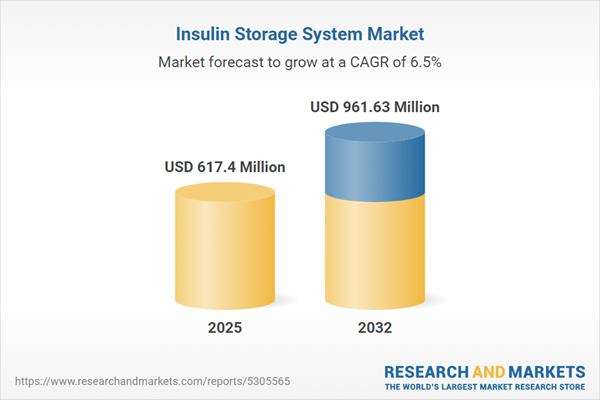Speak directly to the analyst to clarify any post sales queries you may have.
The insulin storage system market is experiencing rapid transformation as technology and regulation evolve alongside shifting care demands. Senior leaders require clear, actionable insight to navigate new compliance requirements, drive operational excellence, and strategically prepare for future healthcare delivery models.
Market Snapshot: Insulin Storage System Market Growth and Outlook
The global insulin storage system market is valued at USD 582.24 million with expectations to reach USD 617.40 million within the next year, reflecting a compound annual growth rate (CAGR) of 6.47%. This growth is driven by increased diabetes prevalence, complex regulatory environments, and a greater focus on medication safety across healthcare settings. Providers are prioritizing investments in resilient storage infrastructure, ensuring effective medication management and supporting higher standards of patient care. Evolving care models and a consumer shift toward home-based treatment escalate the demand for reliable, compliant storage solutions. Senior decision-makers consistently assess their organizations’ agility and capability to maintain competitive positions and regulatory alignment in these dynamic conditions.
Scope & Segmentation in the Insulin Storage System Market
Understanding the landscape of the insulin storage system market enables organizations to optimize strategies around target regions, procurement, and compliance. Well-defined segmentation supports informed decisions, investment planning, and risk mitigation.
- Product Types: Secure storage bags, protective boxes, dedicated storage devices, and multipurpose units are implemented across hospitals, clinics, and home care environments to address varied storage and access needs.
- Material Types: Composites, glass, metal, and plastic each bring unique attributes for compliance, durability, and functional suitability, enabling tailored system design aligned with clinical and operational requirements.
- Temperature Control Methods: Manual and automated technologies help maintain insulin efficacy and minimize waste, with smart solutions supporting greater consistency across care contexts.
- Functionalities: Alarms, environmental monitoring, and digital tracking features streamline daily operations, improve medication security, and support quick response when conditions change.
- End Users: Hospitals, individual users, clinical providers, and manufacturers have specific storage priorities, including efficient workflow management and secure access for both staff and patients.
- Geographic Regions: Key areas—Americas, Europe, Middle East & Africa, Asia-Pacific—offer distinctive market prospects, each influenced by local healthcare infrastructure, regulatory standards, and supply chain partnership models.
- Leading Companies: Arkray Healthcare Pvt Ltd, COOL sarl, Cooluli USA, DISONCARE, Godrej & Boyce, Medicool Inc., Novo Nordisk A/S, ReadyCare LLC, Sanofi S.A., SOOIL Developments, Tonghua Dongbao Pharmaceutical, Wuxi NEST Biotechnology, and Ypsomed Ltd continue to set industry direction and drive innovation across global and regional segments.
Key Takeaways for Senior Decision-Makers
- Upgrading storage infrastructure elevates medication distribution reliability and strengthens compliance, meeting broad regulatory demands across healthcare systems.
- Implementing Internet of Things (IoT) and advanced digital tools improves real-time monitoring, enhancing risk management and supporting faster, data-driven decisions.
- Deploying portable and modular solutions increases flexibility, ensuring organizations can rapidly adapt insulin access for remote and decentralized care models.
- Automated alerts, sensor monitoring, and data logging simplify compliance audits and allow clinical teams to focus on high-impact operational tasks.
- Creating regional partnerships and refining sourcing approaches bolsters resilience and enables quick adaptation to changing supply chain or geopolitical circumstances.
- For those entering Asia-Pacific, a nuanced understanding of provider networks and customized sourcing is critical to building presence and ensuring regulatory alignment.
Impact of 2025 United States Tariffs on Supply Chain and Sourcing
The upcoming 2025 tariffs in the United States are prompting providers to refine their sourcing, manufacturing, and logistics methodologies. Many organizations are investing more heavily in domestic production, reevaluating supplier agreements, and optimizing distribution frameworks to maintain business continuity and adhere to compliance expectations during tariff transitions.
Methodology & Data Sources
Research for this report draws from direct interviews and surveys with engineers, clinicians, and compliance experts, reinforced by thorough review of secondary sources including published studies, patents, and regulatory documents. This blended approach ensures robust, actionable findings for executive strategy.
Why This Report Matters
- Delivers meaningful segmentation and region-specific insights to facilitate deeper understanding and stronger decision-making in the insulin storage system market.
- Aligns procurement and compliance planning with changing global healthcare dynamics and infrastructure requirements.
- Supports focused resource allocation and risk mitigation, enabling organizations to cultivate operational resilience and drive sustained performance.
Conclusion
Senior leaders can apply the findings of this report to adapt to new regulations, leverage advanced technology, and foster long-term excellence in insulin storage management across a range of healthcare settings.
Additional Product Information:
- Purchase of this report includes 1 year online access with quarterly updates.
- This report can be updated on request. Please contact our Customer Experience team using the Ask a Question widget on our website.
Table of Contents
3. Executive Summary
4. Market Overview
7. Cumulative Impact of Artificial Intelligence 2025
Companies Mentioned
The companies profiled in this Insulin Storage System market report include:- Arkray Healthcare Pvt Ltd
- COOL sarl
- Cooluli USA
- DISONCARE
- Godrej & Boyce Manufacturing Company Limited.
- Medicool, Inc
- Novo Nordisk A/S
- ReadyCare, LLC.
- Sanofi S.A.
- SOOIL Developments Co., Ltd
- Tonghua Dongbao Pharmaceutical Co., Ltd.
- Wuxi NEST Biotechnology Co.,Ltd
- Ypsomed Ltd.
Table Information
| Report Attribute | Details |
|---|---|
| No. of Pages | 188 |
| Published | November 2025 |
| Forecast Period | 2025 - 2032 |
| Estimated Market Value ( USD | $ 617.4 Million |
| Forecasted Market Value ( USD | $ 961.63 Million |
| Compound Annual Growth Rate | 6.4% |
| Regions Covered | Global |
| No. of Companies Mentioned | 14 |









